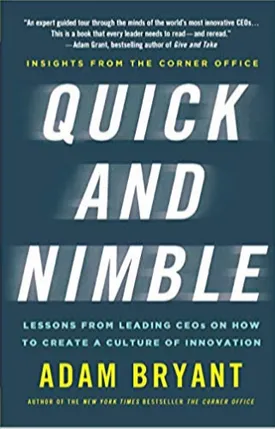Quick and Nimble: Lessons from Leading CEOs on How to Create a Culture of Innovation - Insights from The Corner Office by Adam Bryant
The Corner Office: Indispensable & Unexpected Lessons from CEOs on How to Lead & Succeed, written by Adam Bryant, takes readers on an intriguing journey through the lives and minds of some of the most influential business leaders in the world. Through interviews and a wealth of stories, Bryant reveals the common traits, lessons, and philosophies that successful CEOs rely on to drive innovation, create a culture of creativity, and effect meaningful change.
The book identifies three key lessons which Bryant believes are essential for any business leader looking to build a culture of innovation. The first of these is “the power of quick and nimble.” As CEO of Xerox Anne Mulcahy so aptly puts it: “In a world that is running a million miles an hour, it’s important to be quick. It’s important to be able to move fast and not get stuck.” Mulcahy’s philosophy of speed and agility applies to the whole organization, not just the C-suite. She explains how each individual employee must be prepared to think on their feet, take calculated risks, be adaptive, and continually reevaluate processes.
Bryant’s second lesson is “the need to trust intuition.” This can be a difficult mindset for those who are used to relying on data or a structured approach, but the largest and most successful organizations depend on it. From Pat Woertz of Archer Daniels Midland to Mark Pincus of Zynga, the major theme is that innovation requires a level of trust and faith in ones’ own instincts. In other words, CEOs need to have the courage to follow their gut, regardless of the consequences.
The third lesson of The Corner Office is “the need to surround yourself with a loyal team.” Mike Ferrell, the CEO of Ellie Mae, likens his role to the coach of a football team, where the most important thing is to “get the right people in the right positions and ensure they have a sense of loyalty and commitment.” By fostering an atmosphere of inclusivity and collaboration—and by rewarding performance—Smart Leaders are able to create an environment in which creativity and innovation can thrive.
Taken as a whole, The Corner Office provides a refreshing and meaningful glimpse into the lives of successful CEOs and the philosophies that guide their approach to innovation. Each business leader interviewed for the book reveals a unique mindset, but the underlying themes are surprisingly consistent. For a business leader looking to create a culture of creativity and transformation, these three key lessons—the power of quick and nimble, the need to trust intuition, and the need to surround yourself with a loyal team—are invaluable. Together, these concepts can become a powerful force for real and lasting change and serve to remind us that innovation knows no bounds.

